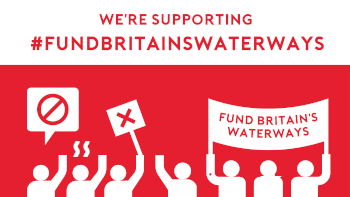Introduction
The Monmouthshire and Brecon Canal is today a welcome refuge for its neighbouring community and a delightful surprise to the adventuring visitor to South Wales. The peace and quiet conceals the chequered history it has followed since its opening at the beginning of the last century. Its sense of timelessness seems contradicted by the fact that it owes its continued existence to events of the last four decades.
Simply conserving historic canal structures in isolation may not be considered to be the best way to retain the character of a waterway. All aspects of a canal’s operation and history should be fully researched, to provide a guide to the particular character of the waterway. This can then be used to help the owners, communities, users, volunteers and developers with the tool for a programme of restoration and conservation.
A Foundation for Restoration and Regeneration
The Monmouthshire, Brecon and Abergavenny canals slowly reduced as commercial waterways during the late 19th century / early 20th century until the last commercial cargo was carried on the Monmouthshire main line in 1938. The British Transport Commission classified the Mon & Brec as a “remainder waterway” in 1955.
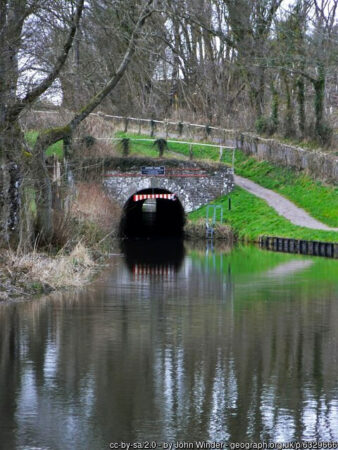
© John Winder – geograph.org.uk/p/6329666
One of the most significant changes to the southern section of canal since its closure in 1930 was to happen as a result of the designation of Cwmbran as a New Town in 1949. This was to provide new employment opportunities following the closure of mining and heavy industry in the southern portion of South Wales. However, the Cwmbran Development Corporation, an organisation with planning powers lacked the foresight to see the potential of the canal. They turned locks into decorative features, replaced canal brides with culverts, and filled-in and culverted some sections.
In the 1960s local people were beginning to show interest in restoring their local disused waterway. In 1963 the British Waterways Board took over running the canal and some restoration / reopening work was done, and it’s status was changed in 1969 when local councils persuaded the BWB that it should be classified as a leisure waterway.
The Inland Waterway Association was active in giving support to members of the local community in opposing much of the development which would affect the future of the canal. Of the changes proposed by the Cwmbran Development Corporation the most damaging was the proposal to build Cwmbran Drive and Greenforge Way in 1982. Following objections submitted by The Inland Waterways Association, Torfaen Canal Preservation Society and The Newport Canal Society a Local Public Inquiry was held. The Planning Inspector report recommended to the Secretary of State that the scheme be allowed subject to a route being reserved for construction of a new canal channel in the event of future restoration. The latter confirming:
“The Secretary of State agrees, however, with the principle that the option of restoring the canal for future navigation should if possible be preserved. With this in mind he accepts his Inspector’s conclusion and recommendation and hereby approve under Section 7 (1) of the New Town Act 1981, the Cwmbran Drive Phase 1, Stage 2 Proposals subject to the modification that the accommodation of a canal cut up to 3m in width is made in the detailed design of the new Victoria Street/Commercial Street Bridge. The Secretary of State anticipated that in this way the future option to make the canal navigable will be preserved and he notes that the land levels also preserve this option at the northern (Clomendy Road) end of the scheme.” Accommodation works to ensure that the canal had a culverted route under Victoria Street – Halfway Bridge (No 41)- were subsequently carried out.
The Start of the Present Day Restoration Initiative
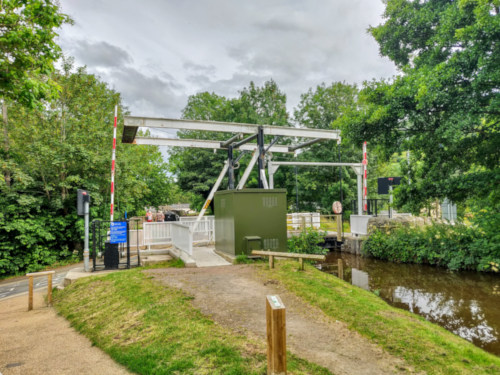
The Newport Canal Society had already achieved the restoration of Gwasted Mawr Lock 34 in 1973/74 by funding an Education project. The lock was restored and re-gated by a maintenance team from British Waterways (River Severn).
At the same time the drawbridge at Talybont On Usk was rebuilt in 1973 to allow navigation through this part of the canal.
A major breach of the canal at Llanfoist was repaired by the BWB in 1975 thus keeping the maintenance and viability of the canal in progress.
A plan for the restoration of the canal was produced by a Planning Group of officers during 1982 representing:
- British Waterways Board
- Brecon Beacons National Park Authority
- Gwent County Council
The Planning Group’s recommendations were the start of a programme of restoration works commencing with the construction of a new navigable culvert in Cwmbran. Restoration of this culvert opened up the navigation to Five Locks Cwmbran.

The Monmouthshire, Brecon and Abergavenny Canals Trust Ltd was formed in 1984. The Trust was formed by combining the resources of the two pioneering groups. The Newport Canal Society and the Torfaen Canal Preservation Society.
The Cwmbran Development Corporation was disbanded in 1988 and their responsibilities were taken over by Torfaen County Borough Council
The Torfaen Canal Preservation Society along with the Inland Waterways Association South Wales Branch had previously been promoting the restoration of Crown Bridge 48 at Sebastopol, and this was eventually rebuilt in 1995.
The Monmouthshire and Brecon Regeneration Partnership was formed in 1995 between our Trust and Torfaen County Borough Council, Newport City Council, Caerphilly County Council, Monmouthshire County Council, the British Waterways Board (now the Canal & River Trust). Its member volunteers, with assistance from the National Waterway Recovery Group, started hands-on restoration work based projects.
The Restoration Programme
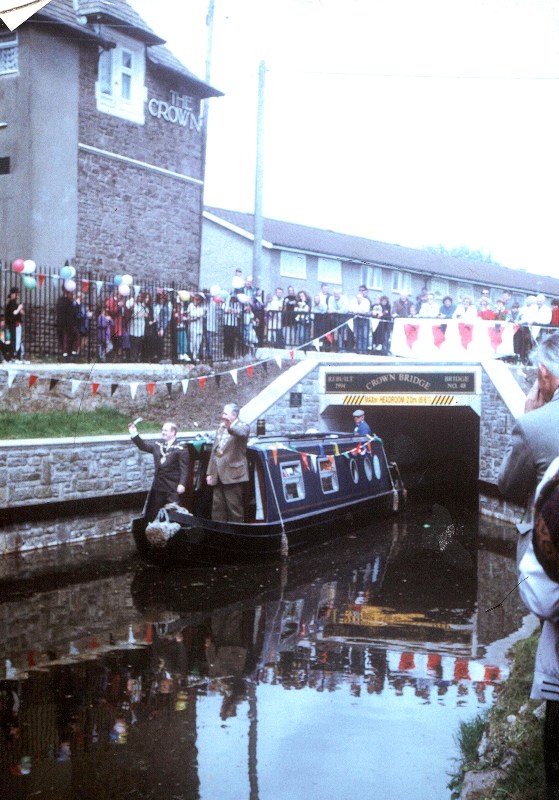
The first project in a major restoration programme by the Regeneration Partnership was in 1997. It focused on restoring the bridge abutments of Ash Tree bridge (No 32) on the boundary between Newport City and Torfaen CBC. This was followed by the restoration of Ty Ffynnon Lock.
On the main line from Newport to Five Locks, Cwmbran locks 34, 35, 36, 37, 38, 39, 40, 41, 42, 43, 44 have all been restored. One aqueduct has been relined, and a replacement lift bridge (No 28) fitted between the Malpas and Bettws estates.
On the Crumlin Arm locks 2, 17, 18, 19, 20, 21 have all been restored. From Newport to Cwmcarn canal towpaths have been resurfaced, and Cwmcarn Aqueduct repaired.
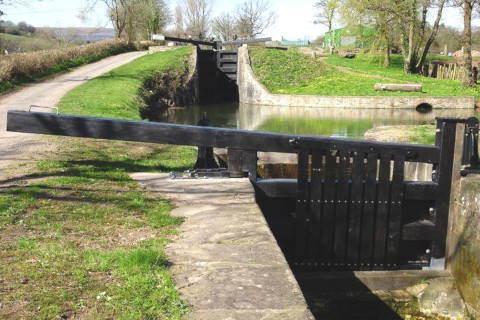
Restoration was funded by a combination of local Council resources, European Regional Development Fund Grants, New Deal Training Grants, Land Fill Credit Receipts Scheme, and Heritage Lottery Grants The projects were managed by the Local Authorities with support from MBACT professional volunteers managing the on-site delivery of the project, Support was also given by tradesman, members of the Waterway Recovery Group, and members of the local communities.
Over the period of the programme over 1400 unemployed community volunteers participated in the scheme learning new skills. 17 locks restored in total. A remarkable achievement.
The restoration programme was put on hold after lock No 44, part of the Heritage Lottery funded Ty Coch Waterworks project, was completed in September 2017, and when local authority investment funds for regeneration projects were depleted.
The owning authorities of Caerphilly, Newport, Torfaen and the Canal & River Trust within financial constraints have undertaken repairs to the structure of the canal, towing path resurfacing, operational water control and general maintenance.
You can see a timeline of the restoration and regeneration history of the canal on our Progress through Partnership timeline page.
The Future
You can read more about our future vision for the canal on Our Trust’s Vision page.
We are also currently involved with a number of on-going initiatives.
Current Project: The Ty Coch Waterway Park
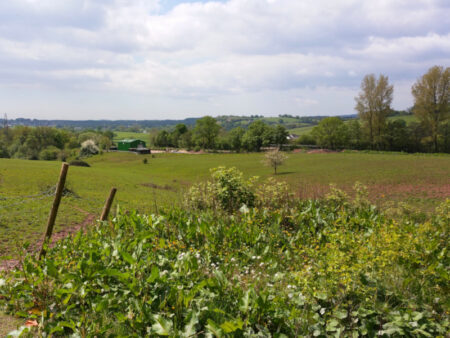
A Trust member working with the unemployed volunteers on the Ty Coch Waterworks project suggested that the land owned by Torfaen County Borough Council and leased out for grassing between the canal and Cwmbran old tip would make an ideal site for a visitor centre. In 2019 Trust members had already excavated a 200 year old saw pit, and adjacent canal workshop foundations including a lock keepers cottage.
Following further investigation a project business plan was developed, funded through a Community Grant which included plans for a restaurant and site for a local farms market shop.

The project would be operated on a commercial theme. Apart from operating costs all profits would be invested back into canal restoration projects.
The Trust currently has an application in with the Heritage Lottery Fund to support the project. The application was delayed during 2020 due to the Covid 19 pandemic.
Read more about this project on our Proposed Ty Coch Waterway Park page.
Current Project: The Adventure Triangle
The “Adventure Triangle” scheme, (also currently in progress), is a jointly administered project by Torfaen and Caerphilly Councils. It is funded by the Welsh Government ERDF Tourism Fund with match funding support from the Local Authorities and Canal & River Trust. The MBACT has provided partnership and design support.
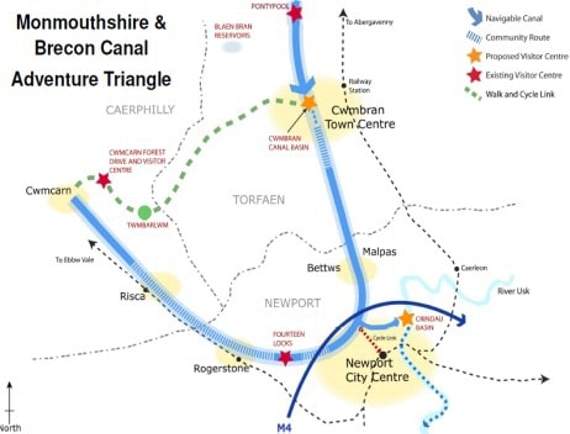
Key elements of this scheme are:
- Construction of a connecting footpath and cycle way between Cwmbran and Cwmcarn. (Work in progress)
- Dredging the canal between Lower Wern Bridge (No 57) and Five Locks
- Cwmbran. (Completed)
- Improving visitor facilities at Pontymoile Base (Planning consultation to take place shortly)
- Visitor facilities to be improved at Five Locks basin. Installation of electrics, fresh water and pump-out facilities for boat owners. (Completed)
- New leisure facilities at Upper Pontnewydd Bridge (No 42a) (Work in progress)
